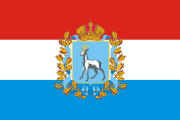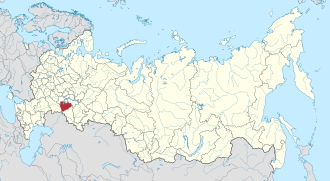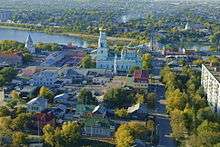Samara Oblast
Samara Oblast (Russian: Сама́рская о́бласть, tr. Samarskaya oblast, IPA: [sɐˈmarskəjə ˈobləsʲtʲ]) is a federal subject of Russia (an oblast). Its administrative center is the city of Samara. From 1935 to 1991, it was known as Kuybyshev Oblast (Russian: Ку́йбышевская о́бласть, tr. Kuybyshevskaya Oblast, IPA: [ˈkujbɨʂɨfskəjə ˈobləsʲtʲ]). As of the 2010 Census, the population of the oblast was 3,215,532.[10]
Samara Oblast | |
|---|---|
| Самарская область | |
 Flag  Coat of arms | |
| Anthem: Anthem of Samara Oblast[1] | |
 | |
| Coordinates: 53°27′N 50°27′E | |
| Country | Russia |
| Federal district | Volga[2] |
| Economic region | Volga[3] |
| Established | December 5, 1936[4] |
| Administrative center | Samara[5] |
| Government | |
| • Body | Provincial Duma[6] |
| • Governor[7] | Dmitry Azarov (acting)[8] |
| Area | |
| • Total | 53,600 km2 (20,700 sq mi) |
| Area rank | 50th |
| Population (2010 Census)[10] | |
| • Total | 3,215,532 |
| • Estimate (2018)[11] | 3,193,514 (-0.7%) |
| • Rank | 11th |
| • Density | 60/km2 (160/sq mi) |
| • Urban | 80.2% |
| • Rural | 19.8% |
| Time zone | UTC+4 (MSK+1 |
| ISO 3166 code | RU-SAM |
| License plates | 63, 163, 763 |
| OKTMO ID | 36000000 |
| Official languages | Russian[13] |
| Website | http://www.samregion.ru |
The oblast borders Tatarstan in the north, Orenburg Oblast in the east, Kazakhstan (West Kazakhstan Province) in the south, Saratov Oblast in the southwest and Ulyanovsk Oblast in the west.
History
The Russian Empire established a guberniya (governorate) in the area in 1851, the Samara Governorate, which was administered from the city of Samara. During the Revolution of 1905, a rebellion took place in November that year at the village of Novaya Tsarevshchina (now Volzhsky) and spread to the village of Stary Buyan, leading to the formation of the short-lived separatist state, the Stary Buyan Republic, within the governorate. There was little local opposition to the new state, and after the failure of local police to end the rebellion, it was successfully suppressed by a punitive expedition of Cossacks and gendarmes led by the vice-governor of the governorate in Samara.
Under Soviet rule most of the governorate's territory was transformed into the Middle Volga Oblast, which was established on May 14, 1928, and a year later on October 20, 1929, it was again transformed into Middle Volga Krai.[4] On January 27, 1935, Samara and the Middle Volga Krai were renamed Kuybyshev and Kuybyshev Krai, respectively, in honor of the Bolshevik leader Valerian Kuybyshev.[4] On December 5, 1936, Kuybyshev Krai was transformed into Kuybyshev Oblast upon the adoption of the 1936 Soviet Constitution.[4] On January 25, 1991 the city was returned to its original name and the oblast was renamed Samara Oblast.[14] On 1 August 1997 Samara Oblast signed a power-sharing agreement with the federal government, granting it autonomy.[15] This agreement would be abolished on 22 February 2002.[16]
Tolyatti is the largest city in Russia which does not serve as the administrative center of a federal subject.

Administrative divisions
Demographics
Population: 3,215,532 (2010 Census);[10] 3,239,737 (2002 Census);[17] 3,265,586 (1989 Census).[18]
Ethnic groups: According to the 2010 Census, the ethnic makeup of the oblast was:[10]
- 2,645,124 Russians (85.6%)
- 126,124 Tatars (4.1%)
- 84,105 Chuvashes (2.7%)
- 65,447 Mordvins (2.1%)
- 42,169 Ukrainians (1.4%)
- 22,981 Armenians (0.7%)
- 123,691 people were registered from administrative databases, and could not declare an ethnicity. It is estimated that the proportion of ethnicities in this group is the same as that of the declared group.[19]
- Births (2008): 36,439 (11.5 per 1000) [20]
- Deaths (2008): 48,593 (15.3 per 1000)
- Vital statistics for 2012
2009 - 1.42 | 2010 - 1.44 | 2011 - 1.44 | 2012 - 1.54 | 2013 - 1.59 | 2014 - 1.65 | 2015 - 1.71 | 2016 - 1.72(e)
Economy
In 1997, Samara Oblast became one of the few federal subjects to receive the approval of the President of Russia to implement external bonded loans (Presidential decree No. 1212, dated 12.10.1997 "On Creating Conditions to Conduct Loans Operations on the Internal and External Capital Markets").
Samara Oblast (or Samara Region) has several special investment sites which are built to implement new plants, industries, factories, create new jobs and increase investments in the Samara Region.
- Special economic zone of industrial-production type «Togliatti»
- Industrial Park «Preobrazhenka»
- Industrial Park «Chapaevsk»
- Technopark in the sphere of high technologies "Zhiguli Valley"
- Industrial Park «Togliattisyntez»
- Industrial Park «Stavropolskiy»
In order to help Russian and foreign investors to select a site for project implementation, to provide consulting services free of charge Ministry for Economic Development, Investments and Trade of the Samara Region organized a Non-Profit Unitary Organization – Fund "Investment Promotion Agency of the Samara Region".
The Agency cooperates with investors on the "one-stop-shop" principle, as well as:
- Searches for foreign partners according to the companies' priorities;
- Provides investment consulting services and monitors the implementation of investment projects;
- Promotes the investment opportunities of the Samara Region in Russia and foreign countries by participation in conferences, exhibitions, forums and other events.[23]
Politics
During the Soviet period, the high authority in the oblast was shared between three persons: The first secretary of the Samara CPSU Committee (who in reality had the biggest authority), the chairman of the oblast Soviet (legislative power), and the Chairman of the oblast Executive Committee (executive power). Since 1991, CPSU lost all the power, and the head of the Oblast administration, and eventually the governor was appointed/elected alongside elected regional parliament.
The Charter of Samara Oblast is the fundamental law of the oblast. The Legislative Assembly of Samara Oblast is the province's standing legislative (representative) body. The Legislative Assembly exercises its authority by passing laws, resolutions, and other legal acts and by supervising the implementation and observance of the laws and other legal acts passed by it. The highest executive body is the Oblast Government, which includes territorial executive bodies such as district administrations, committees, and commissions that facilitate development and run the day to day matters of the province. The Oblast administration supports the activities of the Governor who is the highest official and acts as guarantor of the observance of the oblast Charter in accordance with the Constitution of Russia.
Governors:
- Konstantin Titov (1991—2007)
- Vladimir Artyakov (2007—2012)
- Nikolay Merkushkin (2012 – 2017)
- Dmitry Azarov (acting) (2017 – )
Religion
According to a 2012 survey[24] 35% of the population of Samara Oblast adheres to the Russian Orthodox Church, 7% are unaffiliated generic Christians, 1% are Orthodox Christian believers who do not belong to any church or are members of non-Russian Orthodox churches, 3% are Muslims, and 1% of the population are adherents of Rodnovery (Slavic folk religion). In addition, 30% of the population declares to be "spiritual but not religious", 13% is atheist, and a further 10% follows other religions or did not give an answer to the question.[24]
Sister relations
References
Notes
- Law On the State Symbols of Samara Oblast
- Президент Российской Федерации. Указ №849 от 13 мая 2000 г. «О полномочном представителе Президента Российской Федерации в федеральном округе». Вступил в силу 13 мая 2000 г. Опубликован: "Собрание законодательства РФ", No. 20, ст. 2112, 15 мая 2000 г. (President of the Russian Federation. Decree #849 of May 13, 2000 On the Plenipotentiary Representative of the President of the Russian Federation in a Federal District. Effective as of May 13, 2000.).
- Госстандарт Российской Федерации. №ОК 024-95 27 декабря 1995 г. «Общероссийский классификатор экономических регионов. 2. Экономические районы», в ред. Изменения №5/2001 ОКЭР. (Gosstandart of the Russian Federation. #OK 024-95 December 27, 1995 Russian Classification of Economic Regions. 2. Economic Regions, as amended by the Amendment #5/2001 OKER. ).
- Administrative-Territorial Structure of the Union Republics. 1987., p. 162
- Charter of Samara Oblast, Article 53
- Charter of Samara Oblast, Article 59
- Charter of Samara Oblast, Article 61
- Official website of Samara Oblast. Biography of the Governor of Samara Oblast (in Russian)
- Федеральная служба государственной статистики (Federal State Statistics Service) (May 21, 2004). "Территория, число районов, населённых пунктов и сельских администраций по субъектам Российской Федерации (Territory, Number of Districts, Inhabited Localities, and Rural Administration by Federal Subjects of the Russian Federation)". Всероссийская перепись населения 2002 года (All-Russia Population Census of 2002) (in Russian). Federal State Statistics Service. Retrieved November 1, 2011.
- Russian Federal State Statistics Service (2011). "Всероссийская перепись населения 2010 года. Том 1" [2010 All-Russian Population Census, vol. 1]. Всероссийская перепись населения 2010 года [2010 All-Russia Population Census] (in Russian). Federal State Statistics Service.
- http://www.gks.ru/free_doc/new_site/population/demo/Popul2018.xls.
- "Об исчислении времени". Официальный интернет-портал правовой информации (in Russian). June 3, 2011. Retrieved January 19, 2019.
- Official throughout the Russian Federation according to Article 68.1 of the Constitution of Russia.
- Decree #526-1
- "Newsline - August 4, 1997 Power-Sharing Agreement Signed with Samara Oblast". Radio Free Europe/Radio Liberty. August 1, 1997. Retrieved May 3, 2019.
- Chuman, Mizuki. "The Rise and Fall of Power-Sharing Treaties Between Center and Regions in Post-Soviet Russia" (PDF). Demokratizatsiya: 146.
- Russian Federal State Statistics Service (May 21, 2004). "Численность населения России, субъектов Российской Федерации в составе федеральных округов, районов, городских поселений, сельских населённых пунктов – районных центров и сельских населённых пунктов с населением 3 тысячи и более человек" [Population of Russia, Its Federal Districts, Federal Subjects, Districts, Urban Localities, Rural Localities—Administrative Centers, and Rural Localities with Population of Over 3,000] (XLS). Всероссийская перепись населения 2002 года [All-Russia Population Census of 2002] (in Russian).
- "Всесоюзная перепись населения 1989 г. Численность наличного населения союзных и автономных республик, автономных областей и округов, краёв, областей, районов, городских поселений и сёл-райцентров" [All Union Population Census of 1989: Present Population of Union and Autonomous Republics, Autonomous Oblasts and Okrugs, Krais, Oblasts, Districts, Urban Settlements, and Villages Serving as District Administrative Centers]. Всесоюзная перепись населения 1989 года [All-Union Population Census of 1989] (in Russian). Институт демографии Национального исследовательского университета: Высшая школа экономики [Institute of Demography at the National Research University: Higher School of Economics]. 1989 – via Demoscope Weekly.
- "Перепись-2010: русских становится больше". Perepis-2010.ru. December 19, 2011. Retrieved August 13, 2012.
- "Естественное движение населения в разрезе субъектов Российской Федерации". www.gks.ru. Retrieved March 31, 2018.
- "Каталог публикаций::Федеральная служба государственной статистики". www.gks.ru. Retrieved March 31, 2018.
- "Invest In Samara | Инвестиционная привлекательность Самарской области". investinsamara.ru. Retrieved September 7, 2017.
- "Arena: Atlas of Religions and Nationalities in Russia". Sreda, 2012.
- 2012 Arena Atlas Religion Maps. "Ogonek", № 34 (5243), 27/08/2012. Retrieved 21/04/2017. Archived.
- "Раздел > Основная информация о Венгрии > Информация от А до Я Города побратимы, cотрудничающие области". vengria.ru. September 19, 2012. Archived from the original on September 19, 2012. Retrieved March 31, 2018.
Sources
- Самарская Губернская Дума. Закон №22-ГД от 13 октября 1998 г. «О государственных символах Самарской области», в ред. Закона №146-ГД от 31 декабря 2014 г. «О внесении изменения в статью 2 Закона Самарской области "О государственных символах Самарской области"». Вступил в силу с момента опубликования (17 октября 1998 г.). Опубликован: "Волжская коммуна", No.186, 17 октября 1998 г. (Samara Governorate Duma. Law #22-GD of October 13, 1998 On the State Symbols of Samara Oblast, as amended by the Law #146-GD of December 31, 2014 On Amending Article 2 of the Law of Samara Oblast "On the State Symbols of Samara Oblast". Effective as of the moment of publication (October 17, 1998).).
- Самарская Губернская Дума. №179-ГД 18 декабря 2006 г. «Устав Самарской области», в ред. Закона №6-ГД от 11 января 2016 г. «О внесении изменений в Устав Самарской области». Вступил в силу 1 января 2007 г. Опубликован: "Волжская коммуна", №237 (25790), 20 декабря 2006 г. (Samara Governorate Duma. #179-GD December 18, 2006 Charter of Samara Oblast, as amended by the Law #6-GD of January 11, 2016 On Amending the Charter of Samara Oblast. Effective as of January 1, 2007.).
- Президиум Верховного Совета РСФСР. Указ №526-1 от 25 января 1991 г. «О переименовании города Куйбышева в город Самару и Куйбышевской области в Самарскую область». (Presidium of the Supreme Soviet of the RSFSR. Decree #526-1 of January 25, 1991 On Changing the Name of the City of Kuybyshev to the City of Samara and of Kuybyshev Oblast to Samara Oblast. ).
External links

- Official website of Samara Oblast (in Russian)
- Central Eurasian Information Resource: Images of Samara Oblast, University of Washington Digital Collection